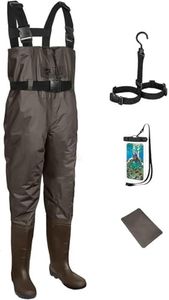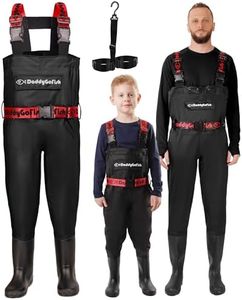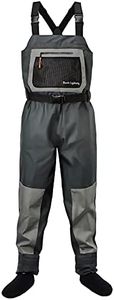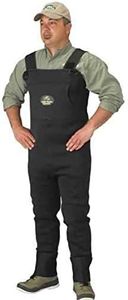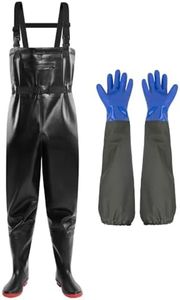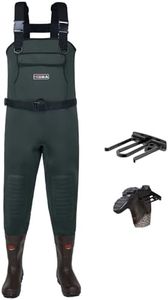We Use CookiesWe use cookies to enhance the security, performance,
functionality and for analytical and promotional activities. By continuing to browse this site you
are agreeing to our privacy policy
10 Best Fly Fishing Waders
From leading brands and best sellers available on the web.Buying Guide for the Best Fly Fishing Waders
Choosing the right fly-fishing waders is important to make sure you stay comfortable, dry, and mobile during your fishing adventures. The right waders should match the type of fishing you do, the environments you fish in, and your personal comfort preferences. By understanding the most important features, you can narrow down your choices and find a pair that best fits your needs. Start by thinking about where and when you’ll fish most often, then use the key specs to help guide your decision.MaterialThe material of the waders determines their comfort, breathability, durability, and weight. Waders are typically made from neoprene, breathable fabrics (like Gore-Tex or similar), or rubber. Neoprene is warm and great for cold water but heavier and less breathable. Breathable fabrics are lighter and more comfortable in a range of temperatures but may be less insulating in very cold water. Rubber waders are usually inexpensive and completely waterproof but are heavy and not breathable, making them suitable for occasional use or dirty conditions. Think about when and where you usually fish: if you fish in cold water, you might want thicker, warmer material; for warmer climates or lots of hiking, lighter, breathable material makes sense.
Wader StyleWader styles include hip waders, waist-high waders, and chest waders. Hip waders only cover your legs up to the hip and are best for shallow waters. Waist-high waders give protection up to your waist, allowing you to fish slightly deeper, but not in very fast or deep water. Chest waders give you the most coverage, reaching up to your chest, so you can wade into deep waters safely. Choose the style based on how deep the water typically is where you fish; if you stick to shallow streams, hip or waist-high might be fine, but for deeper rivers and greater versatility, chest waders are the better choice.
Bootfoot vs. StockingfootWaders come in two main designs: bootfoot and stockingfoot. Bootfoot waders have boots attached, making them easy to slip on and take off, and are great for cold weather or muddy banks, but can be heavier and less secure for walking long distances. Stockingfoot waders have sock-like neoprene feet and require separate wading boots, which often provide better ankle support and traction for lots of walking, hiking, or slippery riverbeds. If you fish close to your car or mainly stand in one spot, bootfoot might be easier. For lots of walking or tricky terrain, stockingfoot paired with quality wading boots is usually preferable.
Fit and SizingThe fit and sizing of your waders will affect your comfort and mobility. Ill-fitting waders can cause chafing, restrict movement, or let water in. Most brands will offer a variety of lengths and sizes to accommodate different body shapes. When choosing your size, ensure there’s enough room for layering clothes underneath in colder weather, but not so much extra space that there’s bunching or risk of snagging. Always try to find the best balance between coverage and comfort for your fishing conditions.
Durability and ReinforcementsDurability is determined by the thickness of the fabric and whether key areas, like the knees and seat, are reinforced. More durable waders have multiple layers or special patches in high-wear areas, which can prevent leaks or tears if you kneel or sit on rough ground often. If you’re frequently scrambling over rocks or fishing in brushy areas, look for reinforced models, while occasional or gentle use might not require as much heaviness.
Pockets and FeaturesExtra features like hand-warmer pockets, waterproof storage, D-rings, or gravel guards can make using your waders more convenient. Hand-warmer pockets are nice in cold weather, while zippered or waterproof pockets let you securely carry gear or a phone. Gravel guards help keep debris out of your boots. Decide which extra features would make your time on the water easier, but stick with what you’ll actually use to avoid unnecessary weight or complexity.




